Review a Repackaging Result
This section discusses:
Repackaging process behavior.
Example of a decrease repackaging plan.
During the Repackaging process, the system updates the Unmet/Overaward Need and Unmet/Overaward COA totals as each award is adjusted. The system does not wait until all awards have been adjusted to calculate these Need Summary totals. The resulting Unmet/Overaward Need and Unmet/Overaward COA values determine whether further reductions or adjustments are necessary.
For the Decrease – Bottom Up Repackaging rule, the system reduces the student's package from bottom up (highest to lowest sequence), but calculates the Need Summary from top down (lowest to highest sequence). If the student's package contains Special Need/Cost awards and the Repackaging Plan is Decrease – Bottom Up, because the system updates the Need Summary totals top down after each award has been reduced, the characteristics of that Special Need/Cost award can change from completely replacing EFC to partially replacing EFC to completely reducing Unmet Need.
The Decrease Repackaging Plan example focuses on the FASS Scholarship, a Special Need/Cost award, to highlight the changing nature of the Meet Need/Cost attribute. This behavior is similar to a Stafford Unsub. With each step in the Repackaging example, the FASS Scholarship amount progresses from completely replacing EFC to completely reducing Unmet Need.
Initially, the student was awarded 740 USD FASS Scholarship. During Repackaging, because the student's EFC is reduced to 560 USD and because this is a Special Need/Cost award, Repackaging reduces the award to match the EFC: The original award of 740 less EFC of 560 equals 180. Therefore, the system reduces the original award by 180.
Revised award = 560 (740 – 180 = 560).
When the system determines that the award is 560 USD, it preserves that award in the student's package. However, because that award is defined as Special/Need Cost, its attribute changes from completely replacing EFC to completely reducing Unmet Need.
Original Package Awards
The Student Aid Package page displays the student's initial set of awards.
Image: Original Package, Student Aid Package page
This example illustrates the fields and controls on the Original Package, Student Aid Package page. You can find definitions for the fields and controls later on this page.
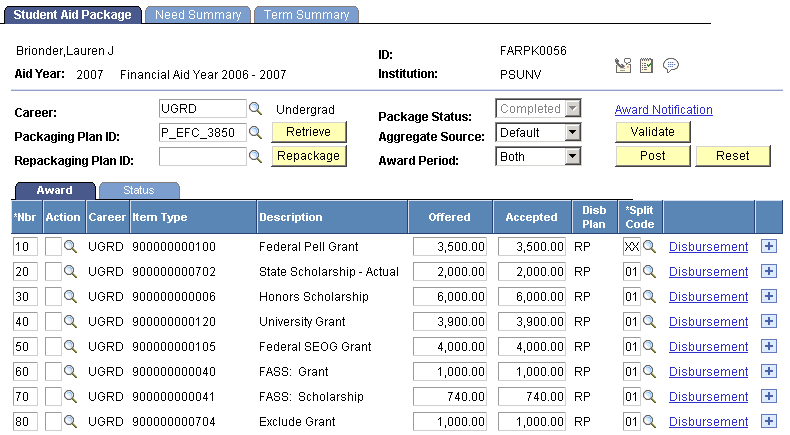
This table lists the relevant attributes for the original awards.
|
Sequence |
Award |
Meet Need/Cost |
Lock |
|---|---|---|---|
|
10 |
Federal Pell Grant |
Straight Need/Cost |
Unlocked |
|
20 |
State Scholarship |
Straight Need/Cost |
Unlocked |
|
30 |
Honors Scholarship |
Special Need/Cost |
Unlocked |
|
40 |
University Grant |
Straight Need/Cost |
Unlocked |
|
50 |
Federal SEOG Grant |
Straight Need/Cost |
Unlocked |
|
60 |
FASS Grant |
Straight Need/Cost |
Locked |
|
70 |
FASS Scholarship |
Special Need/Cost |
Unlocked |
|
80 |
Exclude Grant |
Straight Need/Cost |
Locked |
After the original package is made to the student, a change to COA or EFC occurs that forces the student into an overaward situation. As a result, the student is overawarded in both Need and COA.
Original Need Summary Totals
The Need Summary page displays the student's need summary totals after Packaging.
Image: Need summary totals after Packaging
This example illustrates the fields and controls on the Need summary totals after Packaging. You can find definitions for the fields and controls later on this page.
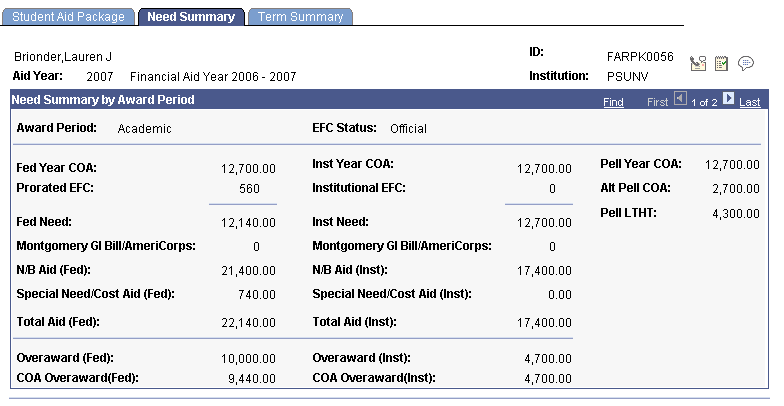
The administrator determines that the student needs to be repackaged.
Decrease-Bottom Up Repackaging Plan
The Repackaging Plan page displays the Decrease – Bottom Up plan to be applied.
Image: Decrease — Bottom Up Repackaging plan
This example illustrates the fields and controls on the Decrease — Bottom Up Repackaging plan.

Step 1
The system first determines that the student is overawarded. It then locates the highest sequenced award, Exclude Grant, and evaluates it. Exclude Grant is a Straight Need/Cost award. Because it is a locked award, the system does not reduce it; it is preserved and remains unchanged. The system then updates the Need Summary totals (top down) for Unmet/Overaward Need and Unmet/Overaward COA.
Image: Step 1 calculation
This example illustrates the Step 1 calculation.

This the Need Summary result after the system processes the Exclude Grant.
Image: Result of step 1 calculation
This example illustrates the Result of step 1 calculation.
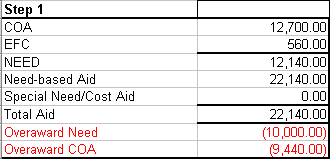
The student is still overawarded.
Step 2
The next sequenced award, bottom up, is the FASS Scholarship. This is an unlocked Special Need/Cost award. Because the student is overawarded, the Special Need/Cost attribute is applied, and the system reduces the award down to match the EFC: The original award of 740 less EFC of 560 equals 180. Therefore, the system reduces the original award by 180.
Revised award = 560 (740 – 180 = 560).
After the reduction is made, the system then updates the Need Summary totals (top down). Both the COA and Need running totals are reduced based on existing awards as well as on the revised 560 USD FASS Scholarship. In this step, the FASS Scholarship completely replaces EFC.
Image: Step 2 calculation
This example illustrates the Step 2 calculation.
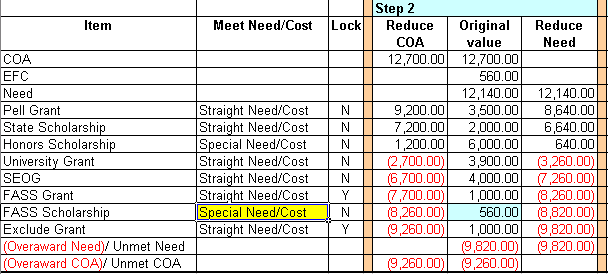
This the Need Summary result after the system processes the FASS Scholarship.
Image: Result of step 2 calculation
This example illustrates the Result of step 2 calculation.
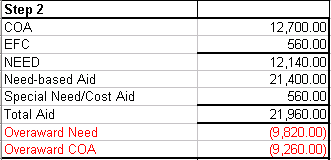
The student is still overawarded.
Step 3
The next sequenced award, bottom up, is the FASS Grant. This is a locked Straight Need/Cost award. Because it is locked, the system preserves the original amount and does not reduce it. The system then updates the Need Summary totals (top down) for Unmet/Overaward Need and Unmet/Overaward COA. In this step, the FASS Scholarship completely replaces EFC.
Image: Step 3 calculation
This example illustrates the Step 3 calculation.
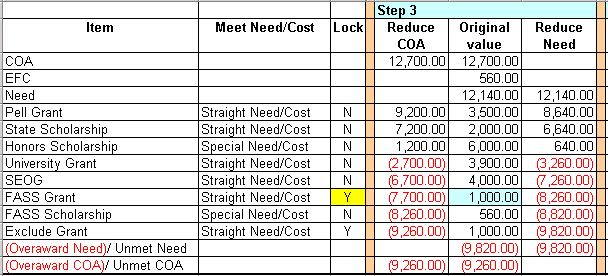
This is the Need Summary result after the system processes the FASS Grant.
Image: Result of step 3 calculation
This example illustrates the Result of step 3 calculation.
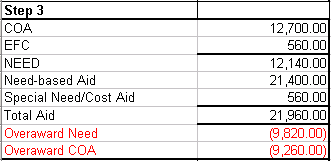
The student is still overawarded.
Step 4
The next sequenced award, bottom up, is the SEOG, an unlocked, Straight Need/Cost award. Because the student still has an Overaward Need amount of 9,820 USD, the system reduces the SEOG award down to 0.00 USD. After the reduction is made, the system updates the Need Summary totals for the student, reducing both the Need and COA totals based on the revised SEOG as well as other existing awards. In this step, the FASS Scholarship completely replaces EFC.
Image: Step 4 calculation
This example illustrates the Step 4 calculation.
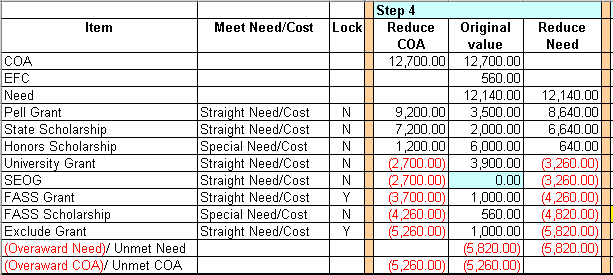
This the Need Summary result after the system processes the SEOG.
Image: Result of step 4 calculation
This example illustrates the Result of step 4 calculation.
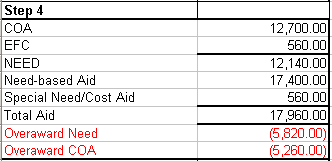
The student is still overawarded.
Step 5
The next sequenced award, bottom up, is the University Grant, an unlocked, Straight Need/Cost award. Because the student's Overaward Need is 5,820 USD, the system reduces the University Grant to 0.00 USD.
The system then updates the Need Summary totals (top down) for Unmet/Overaward Need and Unmet/Overaward COA. After the University Grant reduction, the student is left with remaining Unmet Need and remaining Unmet COA.
The system then subtracts the 1,000 USD locked FASS Grant from the running Need Summary totals. With the handling of this award, it presents a condition in which an overaward exists for Need (–360) but not for COA (+200). Now, because the FASS Scholarship is a Special Need/Cost award, it tries to reduce Unmet Need. Because no Unmet Need exists, it then replaces EFC with 200 USD because Unmet COA is 200 USD. Note that the characteristics of the FASS Scholarship changes since the initial reduction of the FASS Scholarship took place at step 2.
Image: Step 5 calculation
This example illustrates the Step 5 calculation.
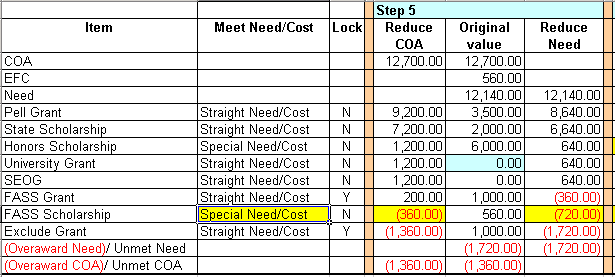
This is the Need Summary after the system processes the University Grant.
Image: Results of step 5 calculation
This example illustrates the Results of step 5 calculation.

The student is still overawarded.
Step 6
The next sequenced award, bottom up, is the Honors Scholarship, an unlocked, Special Need/Cost award. The Overaward Need is 1,720 USD, but from a top down Need Summary perspective, the student has remaining Unmet Need. So the award inherits the Straight Need/Cost characteristic. To account for the Overaward Need of 1,720 USD, the system subtracts 1,720 USD from the original Honors Scholarship amount of 6,000 USD to reduce the award to 4,280 USD (original award 6,000 minus overaward 1,720 equals revised award 4,280).
After reducing the Honors Scholarship, from a Need Summary perspective (top down), the student has remaining Unmet Need of 2,360 USD. Progressing through the package and updating Need Summary, the system accounts for the 1,000 USD FASS Grant, reducing the student's Unmet Need to 1,360 USD. At this point, because the student has remaining Unmet Need and the FASS Scholarship amount of 560 USD is less than the Unmet Need amount of 1,360 USD, the Meet Need/Cost attribute of the FASS Scholarship now inherits the Straight Need/Cost characteristic. This reduces the student's Unmet Need to 800 USD.
Image: Step 6 calculation
This example illustrates the Step 6 calculation.
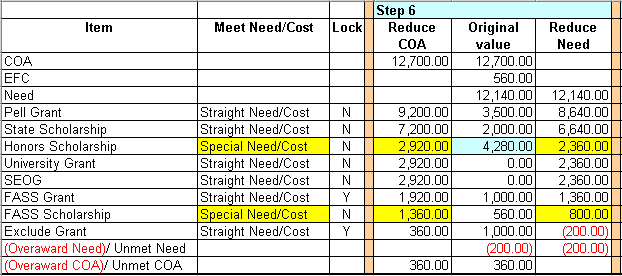
This is the Need Summary result after the system processes the Honors Scholarship.
Image: Results of step 6 calculation
This example illustrates the Results of step 6 calculation.
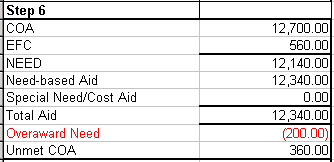
The student is still overawarded in Need.
Step 7
Finally, because the student still has an Overaward Need amount of 200 USD and the Honors Scholarship amount is greater than 0.00 USD, the system reevaluates the Honors Scholarship a second time and reduces it by 200 USD so that the student is no longer in an overaward situation. At this point, when the Need Summary totals are updated, the FASS Scholarship still inherits the Straight Need/Cost characteristic.
Image: Step 7 calculation
This example illustrates the Step 7 calculation.

This is the Need Summary result after the system processes the Honors Scholarship a second time to eliminate the overaward.
Image: Results of step 7 calculation
This example illustrates the Results of step 7 calculation.

The student is no longer in an overaward situation.
Final Award Results
The Student Aid Package page displays the final set of award results.
Image: Final results, Student Aid Package page
This example illustrates the fields and controls on the Final results, Student Aid Package page.

Final Need Summary Results
The Need Summary results page displays the final need totals.
Image: Final need totals, Need Summary page
This example illustrates the fields and controls on the Final need totals, Need Summary page.

At this point, an administrator might choose to repackage the student for an increase to fill the Unmet COA using a Special Need/Cost award.